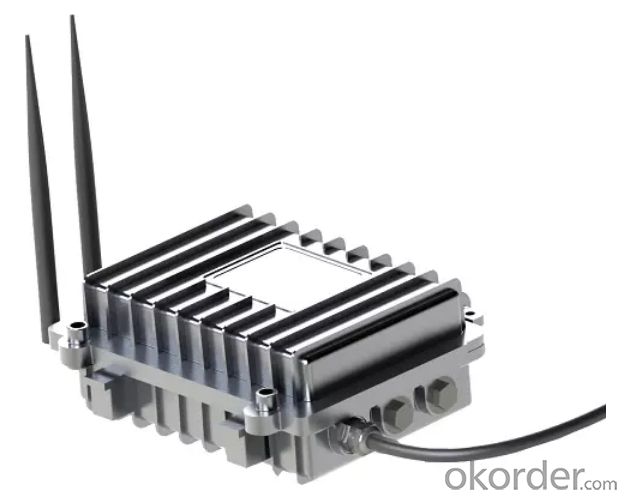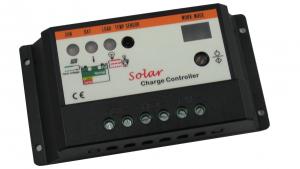IoT Wireless Centralize Controller Remote Monitor System MPPT Solar Charge Controllers 20A
- Loading Port:
- China main port
- Payment Terms:
- TT OR LC
- Min Order Qty:
- 1 pc
- Supply Capability:
- 10000 pc/month
OKorder Service Pledge
OKorder Financial Service
You Might Also Like
1. Features :
*Used GPRS communicate,support 850/900/1800/1900MHz four bands.
*Collection the data of single lamp, protocol conversion, data uploaded to the monitoring system, sending commands to the single lamp controller.
*Combined GPRS communication technology, remote monitoring anytime and anywhere.
*Used zigBee wireless mesh networking technology, support unicast and broadcast mode.
*The standard of industrial products, industrial grade aluminum alloy shell, anti-interference, durable, easy to install.
*The intelligent concentrator routing algorithm
*Support SMS control and setting
*Support ASE128 encryption algorithm
*Support remote online upgrade
*Excellent electromagnetic compatibility, system can work accurately under high voltage pulse, strong magnetic and electrostatic, lightning surge and range temperature variation.
*IP65 waterproof grade
2. Technical parameters
Parameter name | GPRS Concentrator parameter value |
Mode | Depower-DTU |
Power supply | 9~30V |
Operating bands | GPRS |
modulation mode | TCP/IP |
maximum transmit power | EGSM900/GSM850 Class4(2W) |
GSM1800/GSM1900 Class1(1W) | 14≤Vmp≤35(12V), |
Reception sensitivity | <-107dBm |
Wireless | 50Ω/SMA(Female head) |
line-of-sight transmission | Global |
Working temp | -30℃ ~ +75℃ |
Size(exclude antenna) | 113(mm) × 85(mm) × 43(mm) |
Weight | 0.92kg |
3. Detailed image

4. FAQ
Q:DO YOU HAVE ANY CERTIFICATION FOR YOUR PRODUCTS?
A:We have ISO9001:2015,CE、RoHS certifications for all of our products.
Q:DO YOU HAVE MOQ FOR PLACE ORDER?
A:Low MOQ,1pe for sample checking is availabl
- Q: Can a solar controller be used in both residential and commercial applications?
- Yes, a solar controller can be used in both residential and commercial applications. The purpose of a solar controller is to regulate and optimize the charging of batteries in a solar power system. This function is applicable in both residential and commercial settings, making the controller suitable for use in both types of applications.
- Q: Can a solar controller be used with solar panels that are connected to a solar water pump?
- Solar panels connected to a solar water pump can indeed use a solar controller. The solar controller is a necessary part of a solar power system, as it regulates the voltage and current generated by the solar panels. This ensures efficient energy usage and proper distribution to connected devices. With the addition of a solar water pump, the solar controller optimizes power output and safeguards against overvoltage or overcurrent issues. It also monitors battery status, if applicable, and ensures appropriate charging and discharging cycles. All in all, a solar controller plays a vital role in managing and controlling the energy flow within a solar-powered water pump system, guaranteeing its optimal operation and durability.
- Q: How do I install a solar controller in my solar panel system?
- Installing a solar controller in your solar panel system is a relatively straightforward process. Here are the steps to guide you through the installation: 1. Determine the appropriate location: Find a suitable location near your solar panels where you can mount the solar controller. The controller should be protected from direct sunlight, rain, and extreme temperatures. 2. Gather the necessary tools: You will need a screwdriver, wire strippers, electrical tape, and mounting brackets (if not included with the solar controller). 3. Disconnect the solar panels: Before beginning the installation, disconnect the solar panels from the battery and the charge controller, if already installed. 4. Mount the solar controller: Attach the mounting brackets to the solar controller, and then secure the brackets to a suitable surface near the solar panels. Ensure the controller is easily accessible for future maintenance. 5. Connect the battery: Identify the battery terminals on the solar controller and connect the positive (+) and negative (-) leads from the battery. Make sure to follow the proper polarity to avoid damage. 6. Connect the solar panels: Locate the solar panel terminals on the controller and connect the positive (+) and negative (-) leads from the solar panels. Again, ensure the correct polarity to prevent any issues. 7. Secure the connections: Use wire strippers to strip off a small section of insulation from the ends of the wires. Insert the stripped wires into the appropriate terminals on the solar controller and tighten the screws to secure the connections. Ensure all connections are tight and secure. 8. Check the connections: Once all connections are made, double-check that everything is properly connected and tightened. Inspect for any frayed or damaged wires and repair or replace them as necessary. 9. Test the system: Reconnect the solar panels to the charge controller and battery. Turn on the solar panel system and monitor the solar controller to ensure it is functioning correctly. Check for any error or warning messages and troubleshoot accordingly. 10. Perform regular maintenance: After installation, regularly inspect the solar controller for any issues, clean the solar panels, and check the wiring connections. This will help ensure optimal performance and extend the lifespan of your solar panel system. Remember, if you are unsure about any step or lack the necessary electrical knowledge, it's best to consult a professional electrician or solar installer for assistance.
- Q: What is the maximum temperature a solar controller can withstand?
- The maximum temperature a solar controller can typically withstand varies depending on the specific model and manufacturer. However, most high-quality solar controllers are designed to withstand temperatures up to 60-70 degrees Celsius (140-158 degrees Fahrenheit).
- Q: Can a solar controller be used with solar-powered electric fences for livestock?
- Indeed, a solar controller is compatible with solar-powered electric fences designed for livestock. Serving as a vital element within a solar-powered electric fence setup, the solar controller effectively manages the power distribution from the solar panel to the fence energizer. Its primary function is to guarantee efficient charging of the battery and the seamless operation of the fence. Additionally, the solar controller plays a crucial role in safeguarding the battery against overcharging, thus extending its lifespan. Consequently, utilizing a solar controller alongside a solar-powered electric fence for livestock is strongly advised to ensure the system's utmost performance and sustainability.
- Q: Can a solar controller be used with a solar-powered water purification system?
- Yes, a solar controller can be used with a solar-powered water purification system. A solar controller regulates the voltage and current from the solar panels to ensure optimal charging of the batteries. In a solar-powered water purification system, the solar controller will help manage the power flow from the solar panels to the purification unit, ensuring efficient operation and battery charging.
- Q: Can a solar controller be used with a 12V battery bank?
- Yes, a solar controller can be used with a 12V battery bank. Solar controllers are designed to regulate the charging process and protect the batteries from overcharging or discharging. They are compatible with various battery voltages, including 12V, and can effectively manage the flow of energy from solar panels to the battery bank.
- Q: What is the maximum discharge voltage for a solar controller?
- The maximum discharge voltage for a solar controller typically depends on the specific model and manufacturer. However, in general, most solar controllers have a maximum discharge voltage of around 12-24 volts for 12-volt systems and 24-48 volts for 24-volt systems. It is important to consult the product specifications or user manual for accurate information regarding a particular solar controller's maximum discharge voltage.
- Q: How does a solar controller prevent damage to the solar panels during hail or storm events?
- A solar controller, also known as a charge controller, plays a crucial role in preventing damage to solar panels during hail or storm events. Its primary function is to regulate the flow of electricity from the solar panels to the battery bank or grid, ensuring optimal charging and preventing overcharging or overvoltage. During hail or storm events, the solar controller acts as a protective barrier between the solar panels and the external environment. It effectively mitigates the risks associated with hail or storm damage by employing various mechanisms: 1. Voltage Regulation: Solar controllers monitor and regulate the voltage output from the solar panels. In the event of a sudden increase in voltage due to hail or storm-induced power fluctuations, the controller immediately detects the excess voltage and regulates it to a safe level. This prevents the solar panels from being overloaded, which could lead to irreversible damage. 2. Overcurrent Protection: In the event of a storm, heavy winds or debris may cause electrical surges or short circuits in the solar panel system. A solar controller includes overcurrent protection mechanisms that detect any abnormal current flow and immediately disconnects the panels from the battery or grid, preventing damage to the panels or other components. 3. Surge Protection: Hail or storm events often come with power surges or voltage spikes. Solar controllers typically include built-in surge protection features to safeguard the entire system from these voltage fluctuations. These protections prevent damage to the sensitive electronic components of the solar panels, ensuring their longevity and uninterrupted performance. 4. Temperature Monitoring and Protection: Extreme weather conditions during hail or storm events can lead to rapid temperature fluctuations. Solar controllers ensure that the panels are operating within a safe temperature range. They monitor the panel temperature and employ mechanisms such as reducing the charging rate or temporarily shutting down the system if the temperature exceeds the safe limit. By preventing overheating, the solar controller helps to prolong the lifespan of the solar panels. Overall, a solar controller acts as a vital safety mechanism that protects solar panels from potential damage during hail or storm events. It regulates voltage, prevents overcurrent, provides surge protection, and monitors temperature to ensure the panels are operating optimally and within safe parameters. By doing so, it helps to ensure the longevity and efficiency of the solar panel system.
- Q: What is the lifespan of a typical solar controller?
- The duration of a typical solar controller's life can differ based on various factors such as the controller's quality, brand, and specific model. On average, a well-crafted solar controller can endure anywhere from 5 to 15 years. Nevertheless, it is essential to recognize that this estimation serves as a general guideline rather than a guarantee. The lifespan of a solar controller is impacted by a range of elements including the environmental conditions it encounters, the level of maintenance and care it receives, and the workload it handles. Extreme temperatures, humidity, and exposure to severe weather conditions can potentially reduce the controller's lifespan. Furthermore, improper maintenance or excessive workload can also affect its longevity. To maximize the lifespan of a solar controller, it is advisable to select a reputable brand and model, ensure proper installation, and adhere to the manufacturer's guidelines for maintenance and usage. Regular inspections, cleaning, and routine maintenance can help identify any potential issues and prevent premature failure. It is important to note that advancements in technology are continually enhancing the lifespan of solar controllers. Newer models often possess improved durability and reliability, which can extend their lifespan beyond the average estimate. Therefore, staying up-to-date with the latest innovations in solar controller technology is always beneficial to ensure the longest possible lifespan for your system.
Send your message to us
IoT Wireless Centralize Controller Remote Monitor System MPPT Solar Charge Controllers 20A
- Loading Port:
- China main port
- Payment Terms:
- TT OR LC
- Min Order Qty:
- 1 pc
- Supply Capability:
- 10000 pc/month
OKorder Service Pledge
OKorder Financial Service
Similar products
Hot products
Hot Searches
Related keywords


























